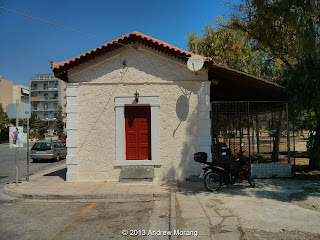Lavrio (Modern Greek: Λαύριο, classical Greek: Λαύριον) is a seaport on the southeast corner of the Attica peninsula, about two hours drive from Athens. This is the warmest part of mainland Greece, and the palms and tropical plants almost make you think you are in the tropics. In antiquity, Lavrio was famous for its silver mines. The mines, worked by slave labor, provided much of the revenue for the Athenian state. Around 483 BC, the mines provided funds to expand the Athenian fleet to 200 triremes, thus laying the foundation of Athenian naval power. According to the
Blue Guide, Greece, some mining was already in progress here in paleolithic times. The mines were eventually exhausted but were reopened in the late 1800s by French and Greek companies to extract manganese, lead, and cadmium.
I think all mining has now ended. But hills around town still have dilapidated factories, industrial buildings, and pieces of machinery.
On the shore road is this half bridge, once probably holding a conveyor system or an ore railroad.
This iron pier extended out into the bay from the half bridge. I noticed the cobble on the beach had a dark red, chunky appearance. It was probably some sort of slag.
Today the modern town is cheerful, and locals and tourists sit in the plazas and enjoy coffees and meals. A ferry goes to Kea (Tzia) island,with connections further to the Cyclades, and there are plenty of yachts in the harbor, so the town has a healthy tourist influx.
Lavrion was the terminal of the Athens-Lavrion Railroad, last used in 1957 (see the 2012 post on the
rail station in Markoupolou). The old depot is now a restaurant. Putting restaurants in old depots is a popular use, but many of these eateries in the USA fail rather quickly.
Here is another railroad building also reused as a restaurant and another one being used for storage.
Photographs taken with a Nexus 4 smart phone (operated by dumb user...).











No comments:
Post a Comment